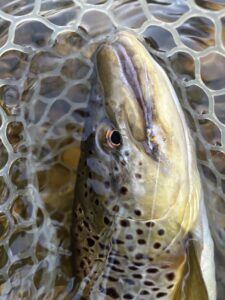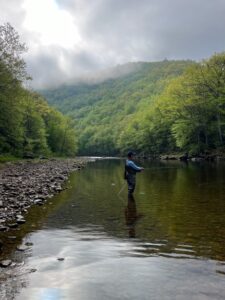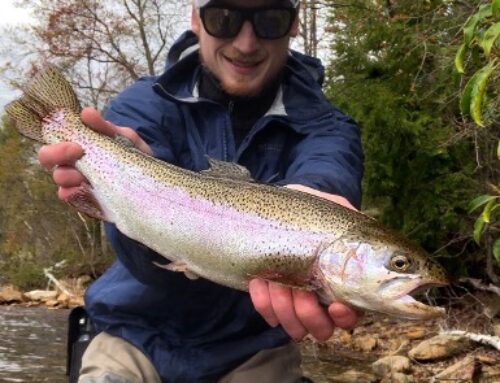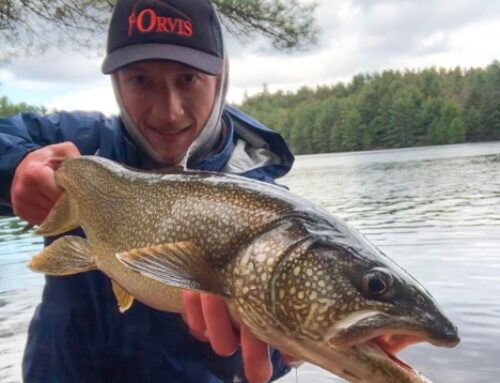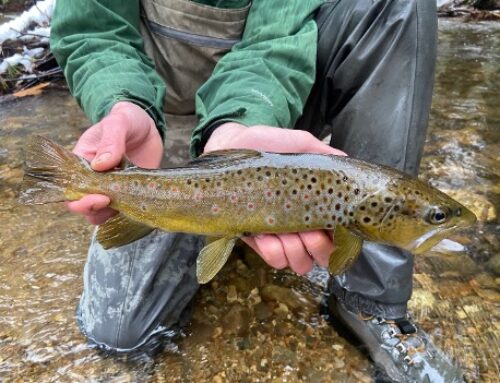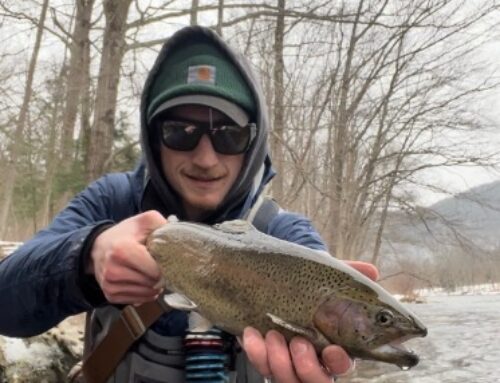Welcome to the heart of spring; the days are long and some of the year’s best fishing is upon us. In fact, there are so many hot bites to chase after right now that choosing can be a bit dizzying.
The Deerfield has been fishing excellently for wading and floating anglers alike. Flows on the Fife Brook stretch have been tantalizingly low for the past week, yielding incredible wading action, especially at the surface. On the upper river, hatches of Hendricksons and other mayflies like blue quills and BWOs have waned a bit in the past week. However, considerably large hatches of caddis have taken their place, keeping the eyes of many fish fixed on the surface. Elk hair variants are a winning ticket for adult caddis imitation, but it’s also a clever idea to drop caddis pupa flies like the OCD caddis or sparkle pupa off high floating elk hair dry flies for that subsurface bite. The caddis hatches have generally been in two distinct sizes–#16 and #12—with tan being a winning color in both cases.
Despite lower numbers of mayflies coming off on the upper river, many fish are still happy to take such imitations. Small CDC and poly-wing emergers (#16-20) have been white hot by themselves, and dry-dropper rigs have been equally effective. Both smaller emergent flies and weighted nymphs (ex: Quasimodo in #16-18) have worked well dropped off higher floating dry flies like klinkhammers and parachutes. In instances when the water is up—usually late morning and early afternoon at the moment—don’t be afraid to size up dry dropper rigs with heavier nymphs to punch through fast water and foam flies like a chubby Chernobyl to float them.
Lower down on the river, mayfly hatches have remained prevalent with solid opportunities for imitation, especially later in the day. When fishing towards dusk, look for spinners on the surface of the water which can yield a deadly bite window when fish get on them. You can’t go wrong with a rusty spinner in a corresponding size to species for this imitation. Lastly, keep eyes sharply peeled for the arrival of sulphurs. If you can believe it, modest hatches have already been observed all up and down the Deerfield, and the meat of this hatch—only a few weeks away—is usually some the year’s best dry fly fishing. We are also seeing more and more March Browns. These big bugs present a great opportunity to prospect for fish as they hatch sporadically throughout the day and the trout key in on the big meal. And don’t forget about Light Cahills, which will be a more common sigfht in the evenings as the coming weeks.
The Westfield River has been at optimum water levels for a couple weeks now and is fishing well. The Millers is finally getting to ideal flows. Though a touch on the higher side still, it is a bug factory this time of year and should provide really good dry fly action for the next couple weeks before it gets too warm. Similar tactics and hatches as those outlined above will also prove effective on these freestones.
Below Quabbin, the Swift River is finally starting to make its way down to more fishable flows after one of the highest winter/early spring seasons in recent memory. As this report is being written, the CFS is running slightly below 300 for the first time since late January. Flows still aren’t exactly ideal, but access is now more than possible throughout the river.
The word is still mostly out on exactly what and how much has spilled into the river from Quabbin, however, we’ve received reports of fish taking large imitations mostly unheard of on the Swift including Pat’s rubber legs and other big bugs. As flows continue to drop, we’ll enter an excellent streamer fishing window which can yield stunning results. In high water years past, lake trout, landlocked salmon, and smallmouth bass spilled in from the reservoir (as well as the river’s larger resident trout) become extremely keen on streamer presentations both stripped and swung. Both single hook patterns like woolly buggers and zonkers as well as articulated options like dungeons and the like are great options as that streamer window continues to materialize.
Looking a bit ahead, flows will hopefully come down to normal in time to support the river’s robust sulphur hatch. In the best years, Swift sulphur hatches represents some of the state’s best dry fly fishing. These beautiful yellowish-orange mayflies usually run in sizes #16-18 on the Swift and are well imitated by sparkle duns, but one also can’t go wrong with a parachute or klinkhammer when fish are really keyed in on them.
As for the area’s creeks and small water, ideal post-runoff flows and the arrival of spring foliage have many small systems performing at their best. Once leaves get on the trees and subsequently bring shade with them, many creek fish that have spent the last several months in their respective system’s deepest, darkest holes redistribute across creeks and begin feeding aggressively. In many situations, fly selection isn’t terribly important; the best bet is often a high floating, durable fly that can take a lot of punishment and still do the job. Stimulators, humpies, elk hair variants, PMXs and foam flies are all stellar options for voraciously aggressive creek fish.
Beyond surface imitation, creeks can fish very well with small streamers, especially after significant flow fluctuations caused by precipitation. Plan to hit creeks with small streamers like woolly buggers, leeches and small zonker flies once flows start to downtrend after rainfall. This is often one of the best ways to contact the larger fish occupying pieces of small water.
This time of year is marked by significant activity from both small and largemouth bass. Each species’ spawn occurs around this time, events that are almost entirely based on water temperature. With temps creeping into the mid 60s, the pre-spawn window has largely closed for smallmouth as many fish make their way to chosen spawning grounds.
Largemouth occupying smaller pieces of still water—which tend to heat up quicker than the area’s rivers and larger lakes—aren’t far behind. Please refrain from casting to spawning fish as scavengers like sunfish will almost immediately raid bass beds for eggs and fry once the guarding adult bass is pulled from the nest; an effect that can yield drastically negative effects on the overall health of the fishery.
Instead, fish along the deeper portions of gravely areas where bass set up their beds/nests. Larger female fish will patrol around these areas before heading shallower to deposit their eggs into nests guarded by male fish. Large streamers like game changers or topwater/deer hair bass bugs are always a good bet, but don’t be afraid to drag craw flies and the like along bottom when the bite gets tough.
The shad run has been going strong for several weeks and have made it up the Connecticut past the Turners Falls dam by now. They can also be found throughout the lower Deerfield and will continue to make their way up this river all the way to the Number Two dam. Small dart flies are deadly on these spring visitors.
Off the water, we’ve got some exciting new stuff on the horizon. We’ll be opening a kiosk in the Zoar Outdoor Adventure facility on Rt. 2 in Charlemont startign Memorial Day weekend that’ll be stocked with essentials and other products if you forget or need to replace anything while fishing the upper river.
Additionally, there is a still water tactics and casting clinic coming up from May 31st-June 2nd hosted and instructed by Pat Johnson and Phil Rowley. For those interested, please email paddy.johnson65@gmail.com to sign up for the program.
Jim Dowd is offering an advanced trout casting clinic on June 12. After a review of sound casting principles and techniques, Jim will guide you through three specialty casts that all trout anglers will want in their arsenal: the reach, the curve and the tuck casts. The two-hour class meets at the shop at 5:30 and only costs $20. It is limited to six students so sign up soon by reaching out to the shop.
The Deerfield River Watershed Trout Unlimited annual Jim Gariepy Fly Fishing tournament is fast approaching. It is a one-day event this year on June 2. This is also Massachusetts free fishing weekend and the Deerfield River will be at lower flows all weekend (weather dependent).
As always, thank you for your continued support of the Deerfield Fly Shop. Make sure to reach out with any questions and we wish you luck next time you’re on the water!



